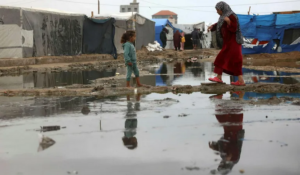Gaza tents flooded with rain, waste, destroying the little Palestinian refugees have left

A tent camp of Palestinian refugees in the central Gaza Strip, on 24 November 2024
Jack Khoury reports in Haaretz on 25 November 2024:
Dalal, a mother of ten living in a tent in the Al-Mawasi humanitarian zone near the southern Gaza city of Khan Yunis, is doing her best to shelter her children from the pouring rain. Everything is essential to her, from a rainproof tent to shoes for her children.
The family is walking around barefoot in the cold rain as mud spreads around them. “We can’t get anything,” she says in tears. “We have no money to buy shoes. I’m trying to improvise from some fabric, or we share the same shoe for several days in the hope that the rain won’t last long.”
Elsewhere in Gaza, near the shoreline, a helpless woman stands. The wind tear apart her tent. “I’m left with nothing, even my improvised tent is destroyed,” she says. “What should I do in this situation? I look at my children, call to heaven and say, ‘Good, enough. It’s better to die from a missile.'”
The recent weather has added to the distress in the Strip, with tents flooding from either rainwater or sewage due to the damaged infrastructure. At this time last year, there were numerous reports of distress caused by rain leaking into homes and tents. But these were the early days of the war, and the number of displaced Palestinians was much smaller.
The situation this year is far worse, with growing distress among the population. More than two million Palestinians across Gaza are now living in destroyed homes or in tents that offer no real shelter for the displaced refugees.
On Sunday, rescue services in Gaza appealed to aid organizations and the international community for immediate aid, including a request for tents and mobile homes for hundreds of many thousands of refugees. The appeal noted that the flooding is causing heavy damage, destroying personal belongings and bedding.
According to the appeal, Gaza is facing a humanitarian catastrophe if displaced Palestinians continue to live under these harsh conditions, particularly in the overcrowded tent camps. The tents provided at the start of the war are no longer adequate to protect the growing numbers of people from the worsening weather, it added.
Gaza Municipality spokesperson Asim Al-Nabih also released a statement in which he listed the scale of the damage and the urgent need for a response in view of the devastated infrastructure and damage to the sewage and rainwater drainage systems in Gaza City.
According to Al-Nabih, more than 175,000 meters (approximately 1.88 million square feet) of sewage pipes, 15,000 meters (about 161,460 square feet) of rainwater drainage pipes, and 105,000 meters (around 1.13 million square feet) of water pipes have been destroyed since the war began. The situation is likely even worse in other areas across the Strip. Al-Nabih emphasized the urgent need for pipelines and maintenance tools to repair Gaza City’s drainage system. However, the Gaza municipality and other partially functioning local councils acknowledge that infrastructure repairs are futile as long as the war continues. It remains unclear who will be able to address this growing crisis.
“We’re in one major chaotic situation,” told Haaretz a Gaza resident who used to work for a human rights organization in the Strip. “A regime of militias and clans is emerging in Gaza. Hamas is still present in some locations, but none of these groups can bring any equipment into Gaza, let alone advance an infrastructure project as long as the sovereign is the Israeli army,” he said.
“We have no idea what will happen. The only thing we see is destruction and devastation, disease and death, and now we also have to cope with winter and rain. It can be summed up in two words: despair and catastrophe.”
This article is reproduced in its entirety
